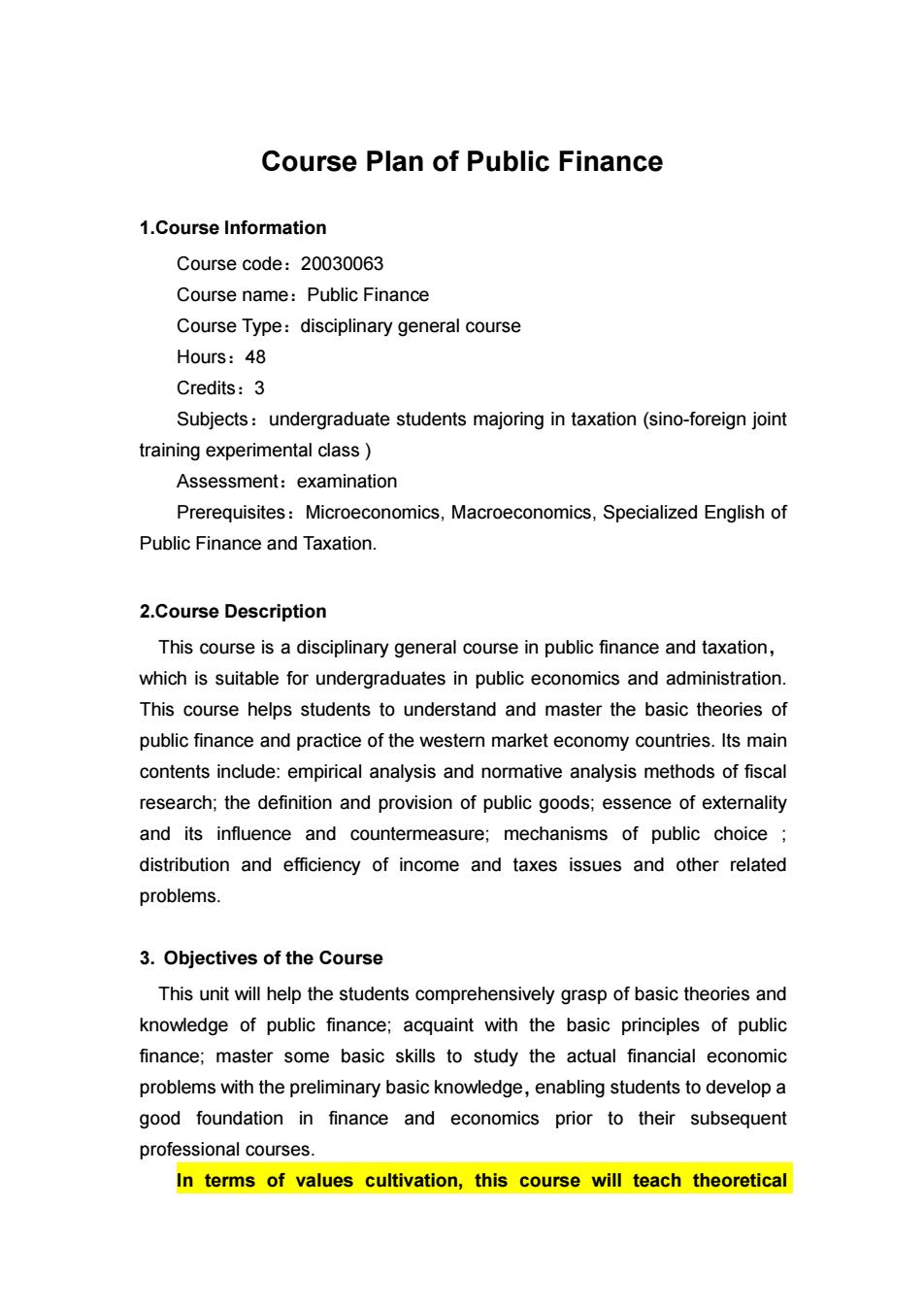
Course Plan of Public Finance 1.Course Information Course code:20030063 Course name:Public Finance Course Type:disciplinary general course Hours:48 Credits:3 Subjects:undergraduate students majoring in taxation(sino-foreign joint training experimental class Assessment:examination Prerequisites:Microeconomics,Macroeconomics,Specialized English of Public Finance and Taxation. 2.Course Description This course is a disciplinary general course in public finance and taxation which is suitable for undergraduates in public economics and administration. This course helps students to understand and master the basic theories of public finance and practice of the western market economy countries.Its main contents include:empirical analysis and normative analysis methods of fiscal research;the definition and provision of public goods;essence of externality and its influence and countermeasure:mechanisms of public choice distribution and efficiency of income and taxes issues and other related problems. 3.Objectives of the Course This unit will help the students comprehensively grasp of basic theories and knowledge of public finance;acquaint with the basic principles of public finance;master some basic skills to study the actual financial economic problems with the preliminary basic knowledge,enabling students to develop a good foundation in finance and economics prior to their subsequent professional courses. In terms of values cultivation,this course will teach theoretical
Course Plan of Public Finance 1.Course Information Course code:20030063 Course name:Public Finance Course Type:disciplinary general course Hours:48 Credits:3 Subjects:undergraduate students majoring in taxation (sino-foreign joint training experimental class ) Assessment:examination Prerequisites:Microeconomics, Macroeconomics, Specialized English of Public Finance and Taxation. 2.Course Description This course is a disciplinary general course in public finance and taxation, which is suitable for undergraduates in public economics and administration. This course helps students to understand and master the basic theories of public finance and practice of the western market economy countries. Its main contents include: empirical analysis and normative analysis methods of fiscal research; the definition and provision of public goods; essence of externality and its influence and countermeasure; mechanisms of public choice ; distribution and efficiency of income and taxes issues and other related problems. 3. Objectives of the Course This unit will help the students comprehensively grasp of basic theories and knowledge of public finance; acquaint with the basic principles of public finance; master some basic skills to study the actual financial economic problems with the preliminary basic knowledge,enabling students to develop a good foundation in finance and economics prior to their subsequent professional courses. In terms of values cultivation, this course will teach theoretical
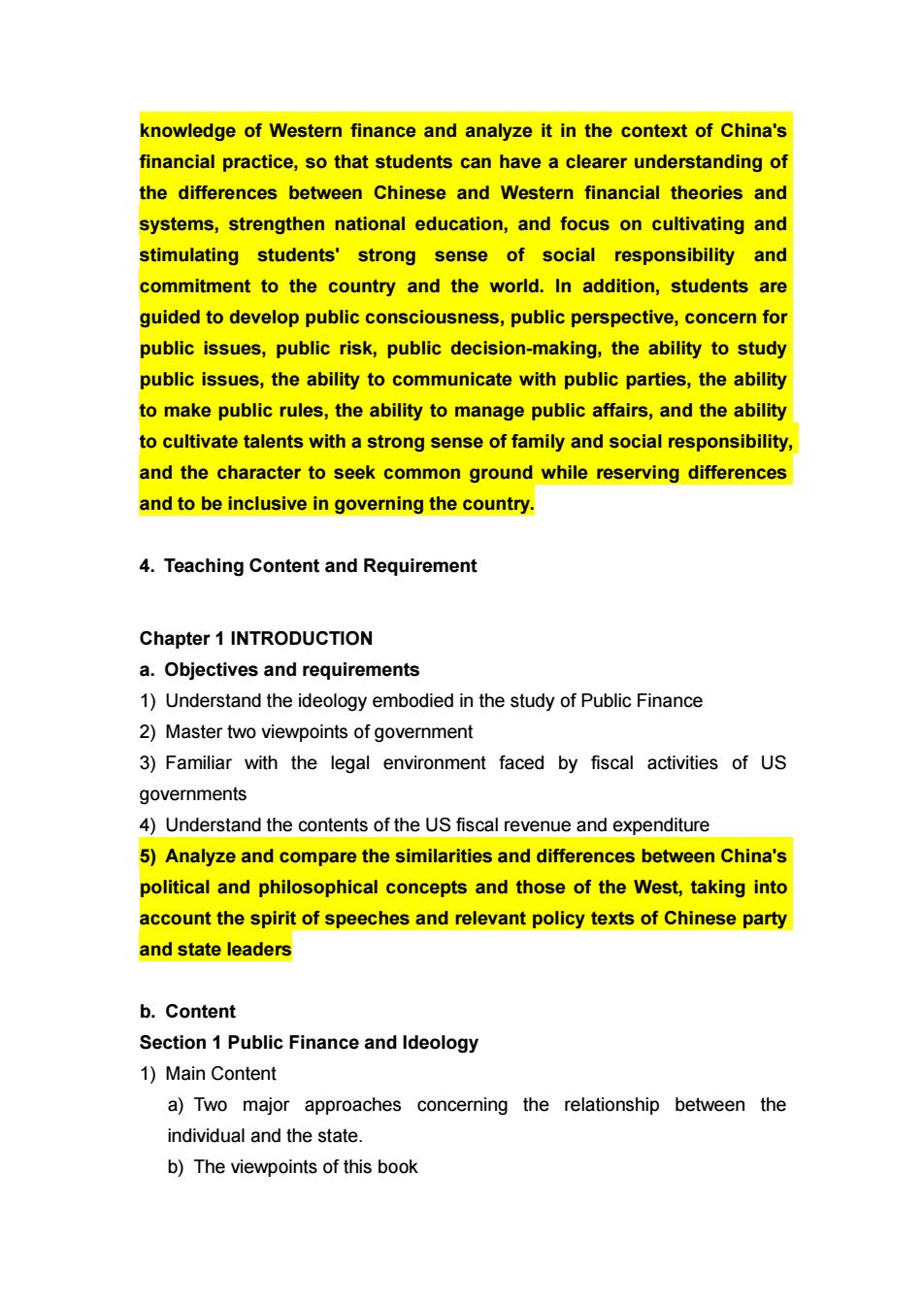
knowledge of Western finance and analyze it in the context of China's financial practice,so that students can have a clearer understanding of the differences between Chinese and Western financial theories and systems,strengthen national education,and focus on cultivating and stimulating students'strong sense of social responsibility and commitment to the country and the world.In addition,students are guided to develop public consciousness,public perspective,concern fo public issues,public risk,public decision-making,the ability to study public issues,the ability to communicate with public parties,the ability to make public rules,the ability to manage public affairs,and the ability to cultivate talents with a strong sense of family and social responsibility. and the character to seek common ground while reserving differences and to be inclusive in governing the country. 4.Teaching Content and Requirement Chapter 1 INTRODUCTION a.Objectives and requirements 1)Understand the ideology embodied in the study of Public Finance 2)Master two viewpoints of government 3)Familiar with the legal environment faced by fiscal activities of US governments 4)Understand the contents of the US fiscal revenue and expenditure 5)Analyze and compare the similarities and differences between China's political and philosophical concepts and those of the West,taking into account the spirit of speeches and relevant policy texts of Chinese party and state leaders b.Content Section 1 Public Finance and Ideology 1)Main Content a)Two major approaches concerning the relationship between the individual and the state. b)The viewpoints of this book
knowledge of Western finance and analyze it in the context of China's financial practice, so that students can have a clearer understanding of the differences between Chinese and Western financial theories and systems, strengthen national education, and focus on cultivating and stimulating students' strong sense of social responsibility and commitment to the country and the world. In addition, students are guided to develop public consciousness, public perspective, concern for public issues, public risk, public decision-making, the ability to study public issues, the ability to communicate with public parties, the ability to make public rules, the ability to manage public affairs, and the ability to cultivate talents with a strong sense of family and social responsibility, and the character to seek common ground while reserving differences and to be inclusive in governing the country. 4. Teaching Content and Requirement Chapter 1 INTRODUCTION a. Objectives and requirements 1) Understand the ideology embodied in the study of Public Finance 2) Master two viewpoints of government 3) Familiar with the legal environment faced by fiscal activities of US governments 4) Understand the contents of the US fiscal revenue and expenditure 5) Analyze and compare the similarities and differences between China's political and philosophical concepts and those of the West, taking into account the spirit of speeches and relevant policy texts of Chinese party and state leaders b. Content Section 1 Public Finance and Ideology 1) Main Content a) Two major approaches concerning the relationship between the individual and the state. b) The viewpoints of this book
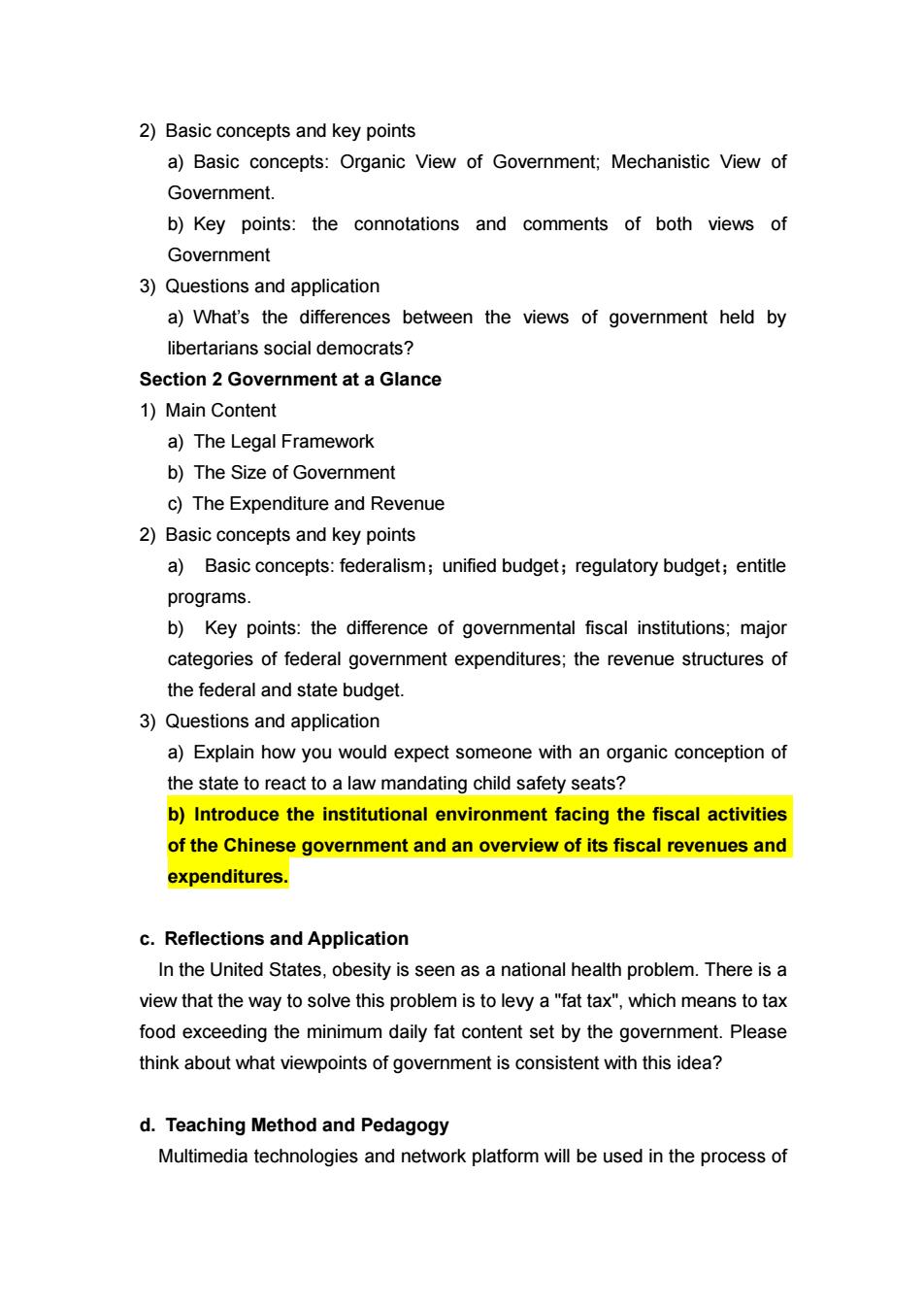
2)Basic concepts and key points a)Basic concepts:Organic View of Government;Mechanistic View of Government. b)Key points:the connotations and comments of both views of Government 3)Questions and application a)What's the differences between the views of government held by libertarians social democrats? Section 2 Government at a Glance 1)Main Content a)The Legal Framework b)The Size of Government c)The Expenditure and Revenue 2)Basic concepts and key points a)Basic concepts:federalism;unified budget;regulatory budget;entitle programs. b)Key points:the difference of governmental fiscal institutions;major categories of federal government expenditures;the revenue structures of the federal and state budget. 3)Questions and application a)Explain how you would expect someone with an organic conception of the state to react to a law mandating child safety seats? b)Introduce the institutional environment facing the fiscal activities of the Chinese government and an overview of its fiscal revenues and expenditures. c.Reflections and Application In the United States,obesity is seen as a national health problem.There is a view that the way to solve this problem is to levy a"fat tax",which means to tax food exceeding the minimum daily fat content set by the government.Please think about what viewpoints of government is consistent with this idea? d.Teaching Method and Pedagogy Multimedia technologies and network platform will be used in the process of
2) Basic concepts and key points a) Basic concepts: Organic View of Government; Mechanistic View of Government. b) Key points: the connotations and comments of both views of Government 3) Questions and application a) What’s the differences between the views of government held by libertarians social democrats? Section 2 Government at a Glance 1) Main Content a) The Legal Framework b) The Size of Government c) The Expenditure and Revenue 2) Basic concepts and key points a) Basic concepts: federalism;unified budget;regulatory budget;entitle programs. b) Key points: the difference of governmental fiscal institutions; major categories of federal government expenditures; the revenue structures of the federal and state budget. 3) Questions and application a) Explain how you would expect someone with an organic conception of the state to react to a law mandating child safety seats? b) Introduce the institutional environment facing the fiscal activities of the Chinese government and an overview of its fiscal revenues and expenditures. c. Reflections and Application In the United States, obesity is seen as a national health problem. There is a view that the way to solve this problem is to levy a "fat tax", which means to tax food exceeding the minimum daily fat content set by the government. Please think about what viewpoints of government is consistent with this idea? d. Teaching Method and Pedagogy Multimedia technologies and network platform will be used in the process of
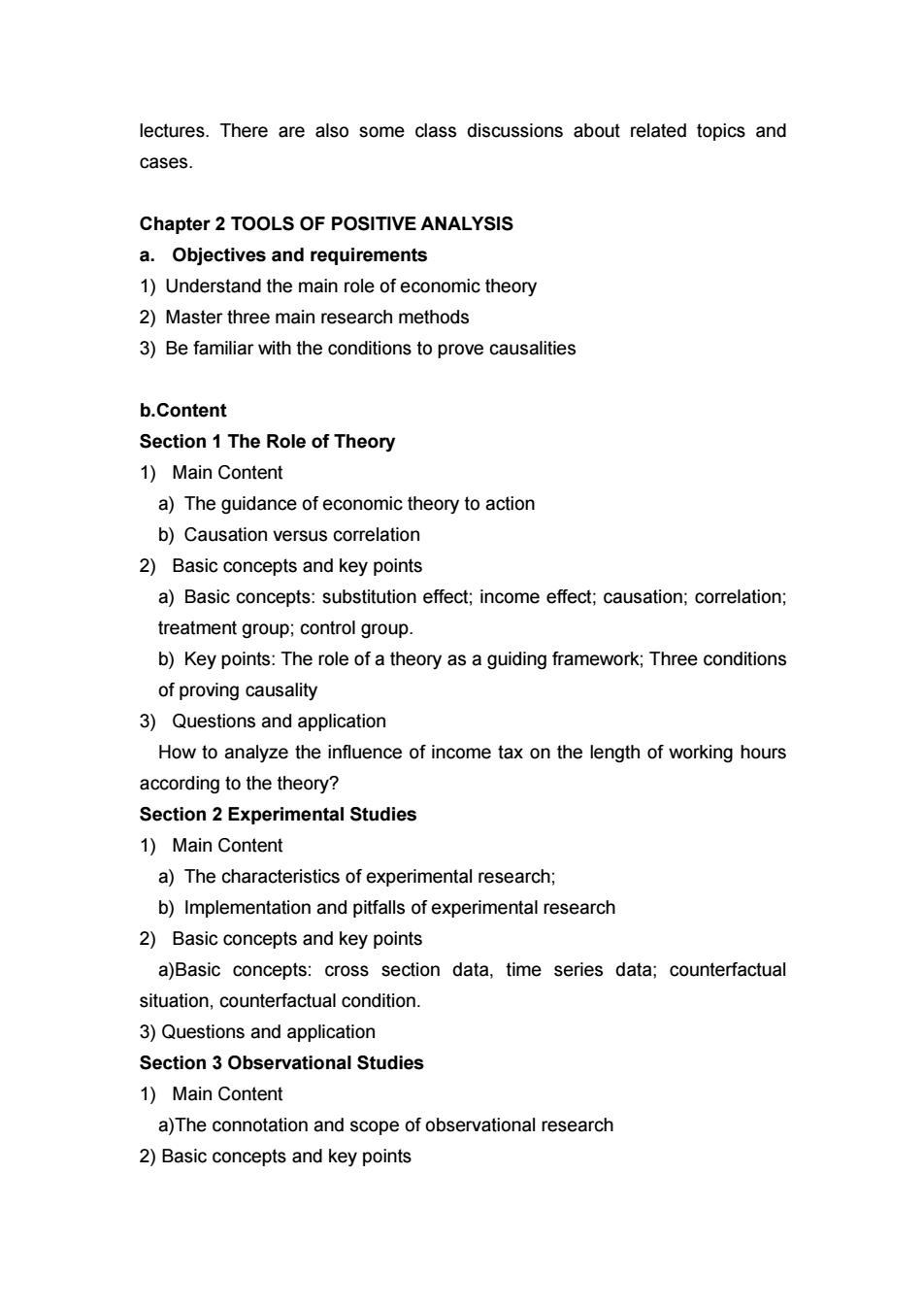
lectures.There are also some class discussions about related topics and cases Chapter 2 TOOLS OF POSITIVE ANALYSIS a.Obiectives and requirements 1)Understand the main role of economic theory 2)Master three main research methods 3)Be familiar with the conditions to prove causalities b.Content Section 1 The Role of Theory 1)Main Content a)The guidance of economic theory to action b)Causation versus correlation 2)Basic concepts and key points a)Basic concepts:substitution effect:income effect;causation;correlation: treatment group;control group. b)Key points:The role of a theory as a guiding framework;Three conditions of proving causality 3)Questions and application How to analyze the influence of income tax on the length of working hours according to the theory? Section 2 Experimental Studies 1)Main Content a)The characteristics of experimental research; b)Implementation and pitfalls of experimental research 2)Basic concepts and key points a)Basic concepts:cross section data,time series data;counterfactual situation,counterfactual condition. 3)Questions and application Section 3 Observational Studies 1)Main Content a)The connotation and scope of observational research 2)Basic concepts and key points
lectures. There are also some class discussions about related topics and cases. Chapter 2 TOOLS OF POSITIVE ANALYSIS a. Objectives and requirements 1) Understand the main role of economic theory 2) Master three main research methods 3) Be familiar with the conditions to prove causalities b.Content Section 1 The Role of Theory 1) Main Content a) The guidance of economic theory to action b) Causation versus correlation 2) Basic concepts and key points a) Basic concepts: substitution effect; income effect; causation; correlation; treatment group; control group. b) Key points: The role of a theory as a guiding framework; Three conditions of proving causality 3) Questions and application How to analyze the influence of income tax on the length of working hours according to the theory? Section 2 Experimental Studies 1) Main Content a) The characteristics of experimental research; b) Implementation and pitfalls of experimental research 2) Basic concepts and key points a)Basic concepts: cross section data, time series data; counterfactual situation, counterfactual condition. 3) Questions and application Section 3 Observational Studies 1) Main Content a)The connotation and scope of observational research 2) Basic concepts and key points
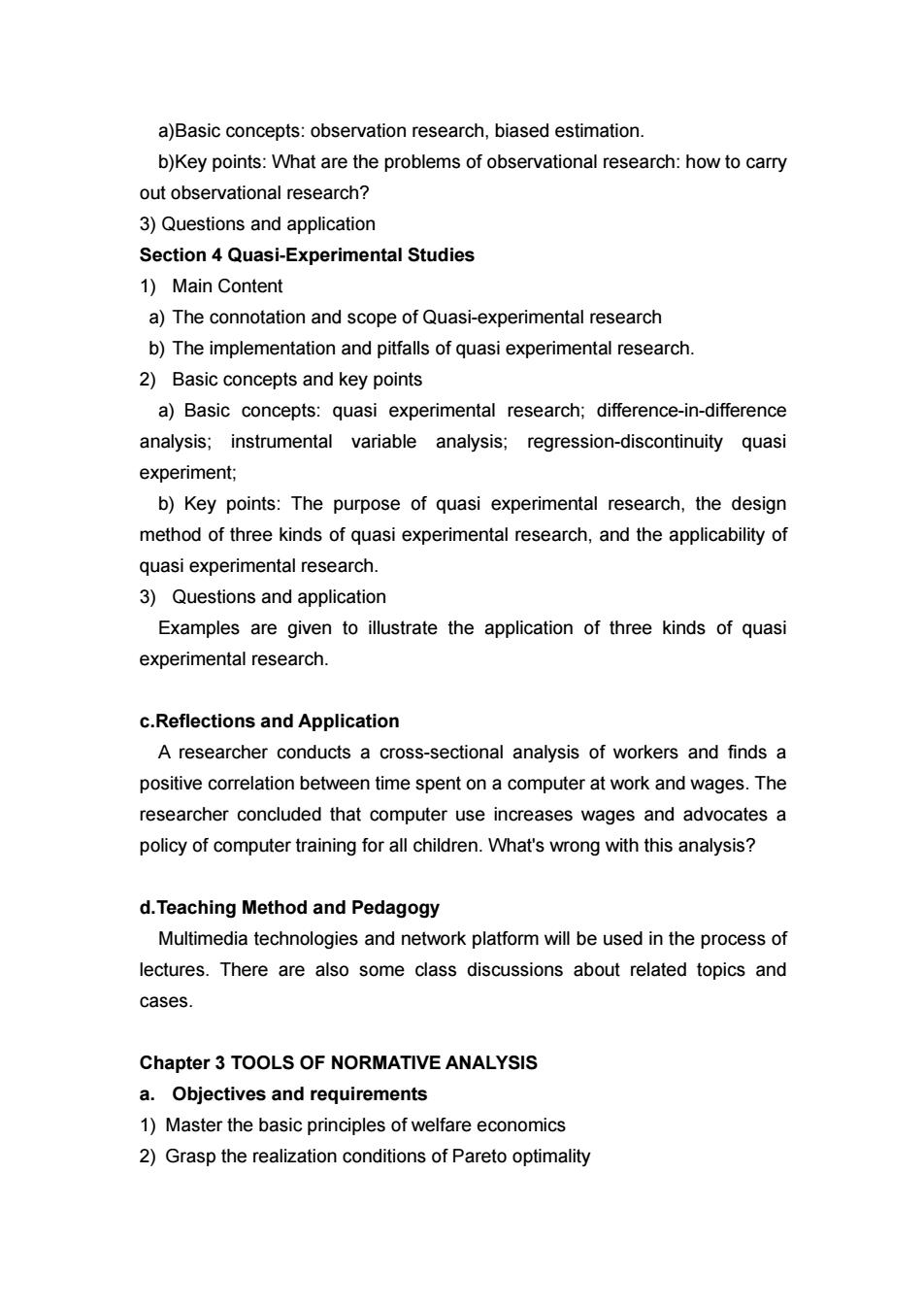
a)Basic concepts:observation research,biased estimation. b)Key points:What are the problems of observational research:how to carry out observational research? 3)Questions and application Section 4 Quasi-Experimental Studies 1)Main Content a)The connotation and scope of Quasi-experimental research b)The implementation and pitfalls of quasi experimental research 2)Basic concepts and key points a)Basic concepts:quasi experimental research;difference-in-difference analysis;instrumental variable analysis;regression-discontinuity quasi experiment; b)Key points:The purpose of quasi experimental research,the design method of three kinds of quasi experimental research,and the applicability of quasi experimental research. 3)Questions and application Examples are given to illustrate the application of three kinds of quasi experimental research. c.Reflections and Application A researcher conducts a cross-sectional analysis of workers and finds a positive correlation between time spent on a computer at work and wages.The researcher concluded that computer use increases wages and advocates a policy of computer training for all children.What's wrong with this analysis? d.Teaching Method and Pedagogy Multimedia technologies and network platform will be used in the process of lectures.There are also some class discussions about related topics and cases Chapter 3 TOOLS OF NORMATIVE ANALYSIS a.Objectives and requirements 1)Master the basic principles of welfare economics 2)Grasp the realization conditions of Pareto optimality
a)Basic concepts: observation research, biased estimation. b)Key points: What are the problems of observational research: how to carry out observational research? 3) Questions and application Section 4 Quasi-Experimental Studies 1) Main Content a) The connotation and scope of Quasi-experimental research b) The implementation and pitfalls of quasi experimental research. 2) Basic concepts and key points a) Basic concepts: quasi experimental research; difference-in-difference analysis; instrumental variable analysis; regression-discontinuity quasi experiment; b) Key points: The purpose of quasi experimental research, the design method of three kinds of quasi experimental research, and the applicability of quasi experimental research. 3) Questions and application Examples are given to illustrate the application of three kinds of quasi experimental research. c.Reflections and Application A researcher conducts a cross-sectional analysis of workers and finds a positive correlation between time spent on a computer at work and wages. The researcher concluded that computer use increases wages and advocates a policy of computer training for all children. What's wrong with this analysis? d.Teaching Method and Pedagogy Multimedia technologies and network platform will be used in the process of lectures. There are also some class discussions about related topics and cases. Chapter 3 TOOLS OF NORMATIVE ANALYSIS a. Objectives and requirements 1) Master the basic principles of welfare economics 2) Grasp the realization conditions of Pareto optimality
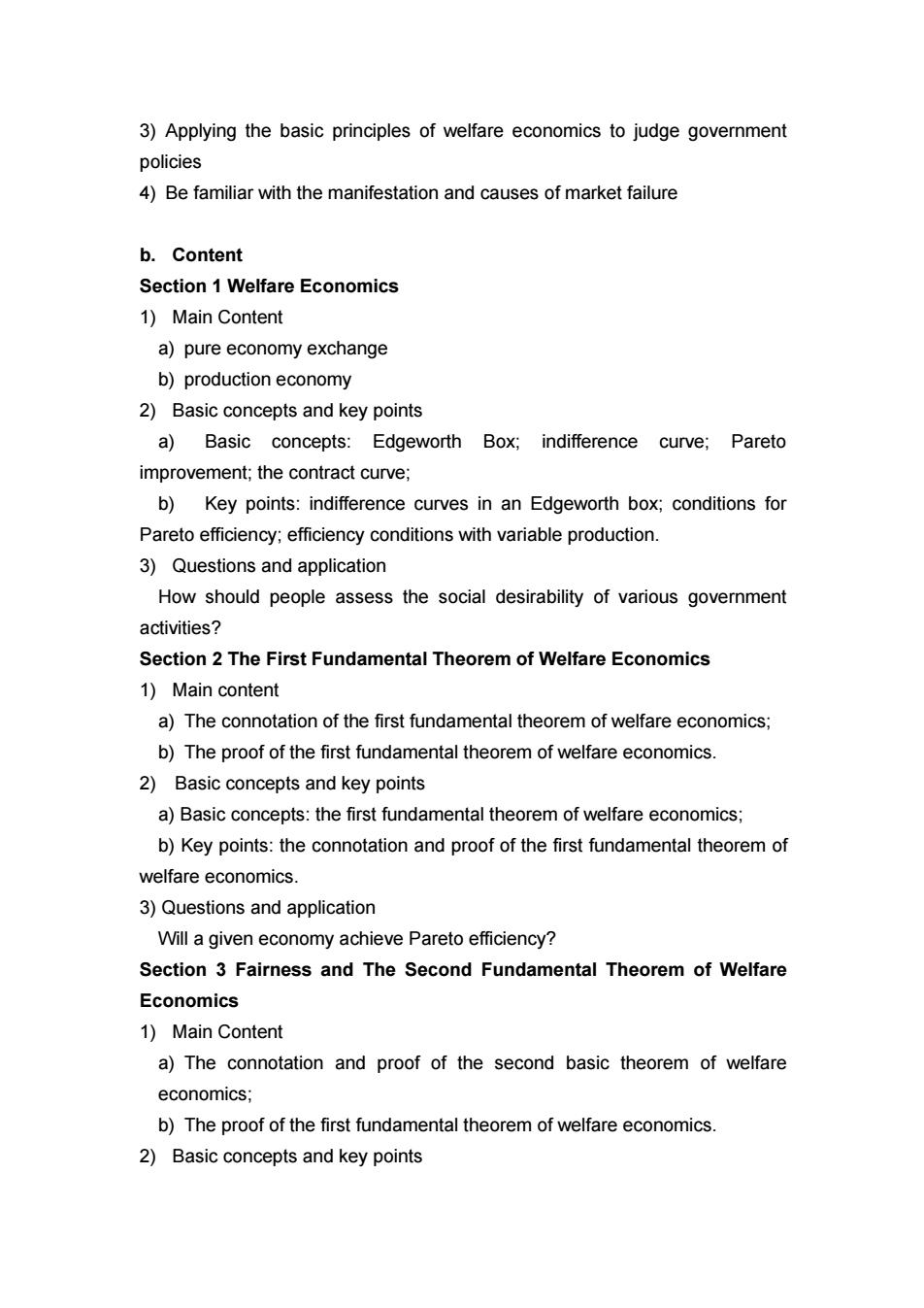
3)Applying the basic principles of welfare economics to judge government policies 4)Be familiar with the manifestation and causes of market failure b.Content Section 1 Welfare Economics 1)Main Content a)pure economy exchange b)production economy 2)Basic concepts and key points a)Basic concepts:Edgeworth Box;indifference curve;Pareto improvement;the contract curve: b)Key points:indifference curves in an Edgeworth box;conditions for Pareto efficiency;efficiency conditions with variable production. 3)Questions and application How should people assess the social desirability of various government activities? Section 2 The First Fundamental Theorem of Welfare Economics 1)Main content a)The connotation of the first fundamental theorem of welfare economics; b)The proof of the first fundamental theorem of welfare economics. 2)Basic concepts and key points a)Basic concepts:the first fundamental theorem of welfare economics; b)Key points:the connotation and proof of the first fundamental theorem of welfare economics 3)Questions and application Will a given economy achieve Pareto efficiency? Section 3 Fairness and The Second Fundamental Theorem of Welfare Economics 1)Main Content a)The connotation and proof of the second basic theorem of welfare economics; b)The proof of the first fundamental theorem of welfare economics. 2)Basic concepts and key points
3) Applying the basic principles of welfare economics to judge government policies 4) Be familiar with the manifestation and causes of market failure b. Content Section 1 Welfare Economics 1) Main Content a) pure economy exchange b) production economy 2) Basic concepts and key points a) Basic concepts: Edgeworth Box; indifference curve; Pareto improvement; the contract curve; b) Key points: indifference curves in an Edgeworth box; conditions for Pareto efficiency; efficiency conditions with variable production. 3) Questions and application How should people assess the social desirability of various government activities? Section 2 The First Fundamental Theorem of Welfare Economics 1) Main content a) The connotation of the first fundamental theorem of welfare economics; b) The proof of the first fundamental theorem of welfare economics. 2) Basic concepts and key points a) Basic concepts: the first fundamental theorem of welfare economics; b) Key points: the connotation and proof of the first fundamental theorem of welfare economics. 3) Questions and application Will a given economy achieve Pareto efficiency? Section 3 Fairness and The Second Fundamental Theorem of Welfare Economics 1) Main Content a) The connotation and proof of the second basic theorem of welfare economics; b) The proof of the first fundamental theorem of welfare economics. 2) Basic concepts and key points
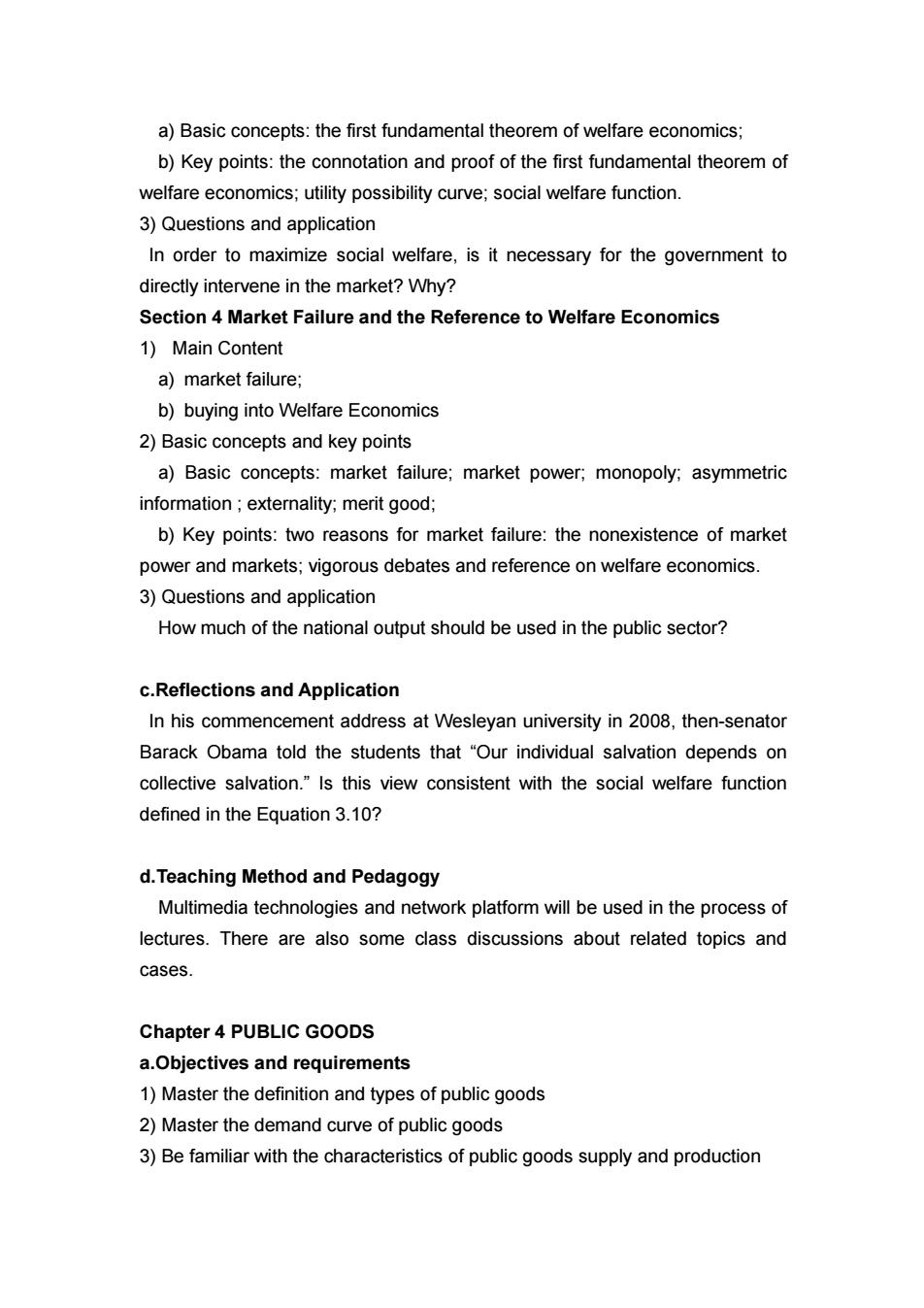
a)Basic concepts:the first fundamental theorem of welfare economics; b)Key points:the connotation and proof of the first fundamental theorem of welfare economics;utility possibility curve;social welfare function. 3)Questions and application In order to maximize social welfare,is it necessary for the government to directly intervene in the market?Why? Section 4 Market Failure and the Reference to Welfare Economics 1)Main Content a)market failure b)buying into Welfare Economics 2)Basic concepts and key points a)Basic concepts:market failure;market power;monopoly;asymmetric information:externality;merit good; b)Key points:two reasons for market failure:the nonexistence of market power and markets;vigorous debates and reference on welfare economics. 3)Questions and application How much of the national output should be used in the public sector? c.Reflections and Application In his commencement address at Wesleyan university in 2008,then-senator Barack Obama told the students that"Our individual salvation depends on collective salvation."Is this view consistent with the social welfare function defined in the Equation 3.10? d.Teaching Method and Pedagogy Multimedia technologies and network platform will be used in the process of lectures.There are also some class discussions about related topics and cases. Chapter 4 PUBLIC GOODS a.Objectives and requirements 1)Master the definition and types of public goods 2)Master the demand curve of public goods 3)Be familiar with the characteristics of public goods supply and production
a) Basic concepts: the first fundamental theorem of welfare economics; b) Key points: the connotation and proof of the first fundamental theorem of welfare economics; utility possibility curve; social welfare function. 3) Questions and application In order to maximize social welfare, is it necessary for the government to directly intervene in the market? Why? Section 4 Market Failure and the Reference to Welfare Economics 1) Main Content a) market failure; b) buying into Welfare Economics 2) Basic concepts and key points a) Basic concepts: market failure; market power; monopoly; asymmetric information ; externality; merit good; b) Key points: two reasons for market failure: the nonexistence of market power and markets; vigorous debates and reference on welfare economics. 3) Questions and application How much of the national output should be used in the public sector? c.Reflections and Application In his commencement address at Wesleyan university in 2008, then-senator Barack Obama told the students that “Our individual salvation depends on collective salvation.” Is this view consistent with the social welfare function defined in the Equation 3.10? d.Teaching Method and Pedagogy Multimedia technologies and network platform will be used in the process of lectures. There are also some class discussions about related topics and cases. Chapter 4 PUBLIC GOODS a.Objectives and requirements 1) Master the definition and types of public goods 2) Master the demand curve of public goods 3) Be familiar with the characteristics of public goods supply and production
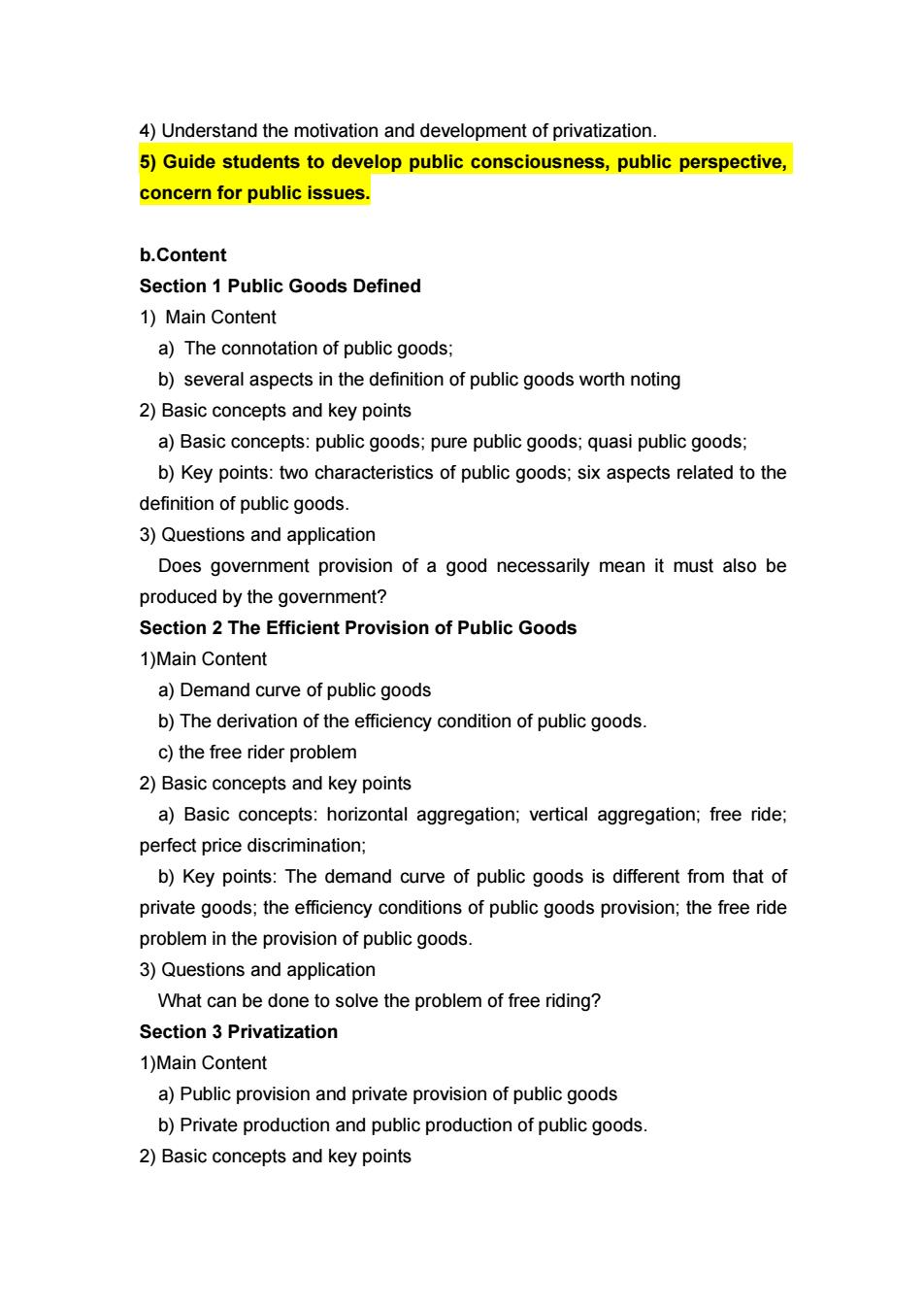
4)Understand the motivation and development of privatization. 5)Guide students to develop public consciousness,public perspective, concern for public issues. b.Content Section 1 Public Goods Defined 1)Main Content a)The connotation of public goods; b)several aspects in the definition of public goods worth noting 2)Basic concepts and key points a)Basic concepts:public goods;pure public goods;quasi public goods; b)Key points:two characteristics of public goods;six aspects related to the definition of public goods 3)Questions and application Does government provision of a good necessarily mean it must also be produced by the government? Section 2 The Efficient Provision of Public Goods 1)Main Content a)Demand curve of public goods b)The derivation of the efficiency condition of public goods. c)the free rider problem 2)Basic concepts and key points a)Basic concepts:horizontal aggregation;vertical aggregation;free ride: perfect price discrimination; b)Key points:The demand curve of public goods is different from that of private goods;the efficiency conditions of public goods provision;the free ride problem in the provision of public goods. 3)Questions and application What can be done to solve the problem of free riding? Section 3 Privatization 1)Main Content a)Public provision and private provision of public goods b)Private production and public production of public goods. 2)Basic concepts and key points
4) Understand the motivation and development of privatization. 5) Guide students to develop public consciousness, public perspective, concern for public issues. b.Content Section 1 Public Goods Defined 1) Main Content a) The connotation of public goods; b) several aspects in the definition of public goods worth noting 2) Basic concepts and key points a) Basic concepts: public goods; pure public goods; quasi public goods; b) Key points: two characteristics of public goods; six aspects related to the definition of public goods. 3) Questions and application Does government provision of a good necessarily mean it must also be produced by the government? Section 2 The Efficient Provision of Public Goods 1)Main Content a) Demand curve of public goods b) The derivation of the efficiency condition of public goods. c) the free rider problem 2) Basic concepts and key points a) Basic concepts: horizontal aggregation; vertical aggregation; free ride; perfect price discrimination; b) Key points: The demand curve of public goods is different from that of private goods; the efficiency conditions of public goods provision; the free ride problem in the provision of public goods. 3) Questions and application What can be done to solve the problem of free riding? Section 3 Privatization 1)Main Content a) Public provision and private provision of public goods b) Private production and public production of public goods. 2) Basic concepts and key points

a)Basic concepts:privatization;incomplete contract; b)Key points:The factors that determine whether a good is provided by the public or by the private;the debate between public production and private production. 3)Questions and application How to understand this sentence:public versus private ownership is less important than whether competition exists? c.Reflections and Application Some privately run airports provide amenities such as pod hotels,which enable fliers to nap between flights.These amenities are generally not available at publicly run airports.Given this,would you recommend that airports be privatized?If not,what other information would you require? d.Teaching Method and Pedagogy Multimedia technologies and network platform will be used in the process of lectures.There are also some class discussions about related topics and cases. Chapter 5 EXTERNALITIES a.Objectives and Requirements 1)Grasp the connotation,types and characteristics of externality. 2)Understand the difference between negative externality and efficiency output. 3)Master the content and application of Coase Theorem. 4)Be familiar with the ways of tax and subsidy to solve externalities. 5)Master the realization of emission fees and cap-and-trade programs. b.Content Section 1 The Nature of Externality 1)Main Content a)The definition of externality: b)Characteristics of externality: c)geometric expression and explanation of externality
a) Basic concepts: privatization; incomplete contract; b) Key points: The factors that determine whether a good is provided by the public or by the private; the debate between public production and private production. 3) Questions and application How to understand this sentence: public versus private ownership is less important than whether competition exists? c.Reflections and Application Some privately run airports provide amenities such as pod hotels, which enable fliers to nap between flights. These amenities are generally not available at publicly run airports. Given this, would you recommend that airports be privatized? If not, what other information would you require? d.Teaching Method and Pedagogy Multimedia technologies and network platform will be used in the process of lectures. There are also some class discussions about related topics and cases. Chapter 5 EXTERNALITIES a.Objectives and Requirements 1) Grasp the connotation, types and characteristics of externality. 2) Understand the difference between negative externality and efficiency output. 3) Master the content and application of Coase Theorem. 4) Be familiar with the ways of tax and subsidy to solve externalities. 5) Master the realization of emission fees and cap-and -trade programs. b.Content Section 1 The Nature of Externality 1) Main Content a) The definition of externality; b) Characteristics of externality; c) geometric expression and explanation of externality
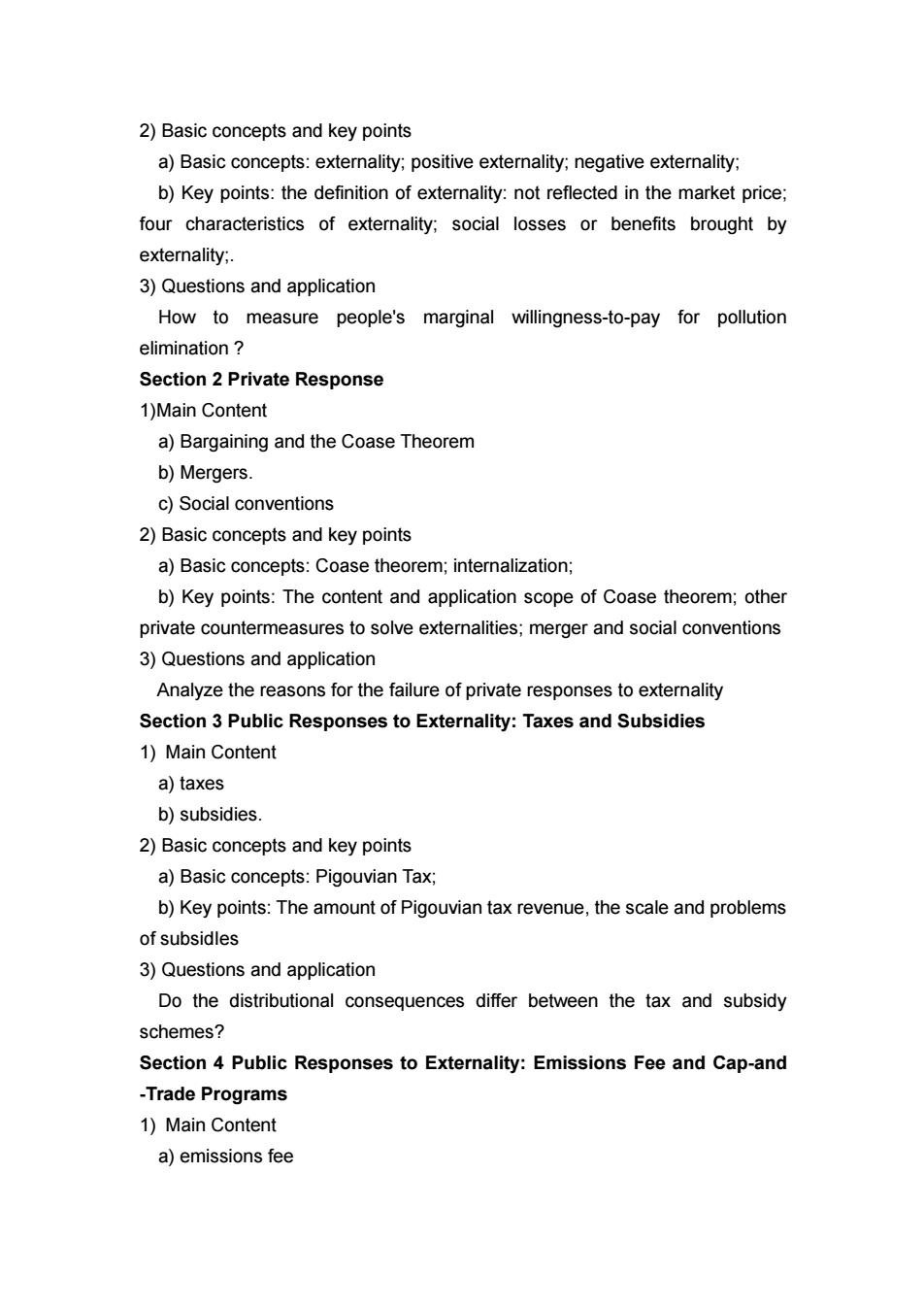
2)Basic concepts and key points a)Basic concepts:externality;positive externality;negative externality; b)Key points:the definition of externality:not reflected in the market price: four characteristics of externality:social losses or benefits brought by externality:. 3)Questions and application How to measure people's marginal willingness-to-pay for pollution elimination Section 2 Private Response 1)Main Content a)Bargaining and the Coase Theorem b)Mergers. c)Social conventions 2)Basic concepts and key points a)Basic concepts:Coase theorem;internalization; b)Key points:The content and application scope of Coase theorem:other private countermeasures to solve externalities;merger and social conventions 3)Questions and application Analyze the reasons for the failure of private responses to externality Section 3 Public Responses to Externality:Taxes and Subsidies 1)Main Content a)taxes b)subsidies. 2)Basic concepts and key points a)Basic concepts:Pigouvian Tax; b)Key points:The amount of Pigouvian tax revenue,the scale and problems of subsidles 3)Questions and application Do the distributional consequences differ between the tax and subsidy schemes? Section 4 Public Responses to Externality:Emissions Fee and Cap-and -Trade Programs 1)Main Content a)emissions fee
2) Basic concepts and key points a) Basic concepts: externality; positive externality; negative externality; b) Key points: the definition of externality: not reflected in the market price; four characteristics of externality; social losses or benefits brought by externality;. 3) Questions and application How to measure people's marginal willingness-to-pay for pollution elimination ? Section 2 Private Response 1)Main Content a) Bargaining and the Coase Theorem b) Mergers. c) Social conventions 2) Basic concepts and key points a) Basic concepts: Coase theorem; internalization; b) Key points: The content and application scope of Coase theorem; other private countermeasures to solve externalities; merger and social conventions 3) Questions and application Analyze the reasons for the failure of private responses to externality Section 3 Public Responses to Externality: Taxes and Subsidies 1) Main Content a) taxes b) subsidies. 2) Basic concepts and key points a) Basic concepts: Pigouvian Tax; b) Key points: The amount of Pigouvian tax revenue, the scale and problems of subsidIes 3) Questions and application Do the distributional consequences differ between the tax and subsidy schemes? Section 4 Public Responses to Externality: Emissions Fee and Cap-and -Trade Programs 1) Main Content a) emissions fee